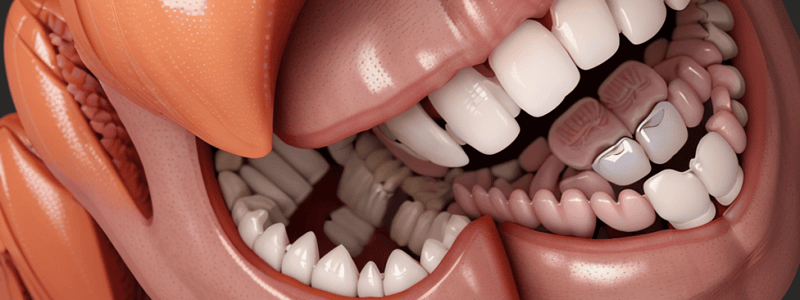Podcast
Questions and Answers
At what stage of development do deciduous teeth first start to develop in humans?
At what stage of development do deciduous teeth first start to develop in humans?
- During the embryonic stage (correct)
- During infancy
- At 6 years of postnatal life
- At 2½ years of age
How many buds are there on the upper and lower arches that eventually become the primary (deciduous) dentition?
How many buds are there on the upper and lower arches that eventually become the primary (deciduous) dentition?
- 5 in total
- 10 in total (correct)
- 15 in total
- 20 in total
When does the eruption of deciduous teeth usually start?
When does the eruption of deciduous teeth usually start?
- At 3 years of age
- From 6 months to 6 years of postnatal life (correct)
- At birth
- 2½ years of age
How many deciduous teeth are there in total?
How many deciduous teeth are there in total?
At what age is deciduous dentition usually complete and in full function?
At what age is deciduous dentition usually complete and in full function?
When is the root formation of all deciduous teeth complete?
When is the root formation of all deciduous teeth complete?
What is the process of shedding primary teeth and their replacement by permanent teeth called?
What is the process of shedding primary teeth and their replacement by permanent teeth called?
Which type of primary dentition is characterized by the absence of spaces, indicating a risk of crowding when larger permanent teeth erupt?
Which type of primary dentition is characterized by the absence of spaces, indicating a risk of crowding when larger permanent teeth erupt?
What is the purpose of primate spaces in the primary dentition?
What is the purpose of primate spaces in the primary dentition?
Which type of terminal plane in primary dentition results in a normal molar relationship?
Which type of terminal plane in primary dentition results in a normal molar relationship?
At what age does the replacement of primary teeth with permanent teeth typically begin?
At what age does the replacement of primary teeth with permanent teeth typically begin?
What causes root resorption in the process of replacing primary teeth with permanent teeth?
What causes root resorption in the process of replacing primary teeth with permanent teeth?
What is the significance of primate spaces in the maxillary arch?
What is the significance of primate spaces in the maxillary arch?
Which type of primary dentition is associated with interdental spaces known as physiologic or generalized spaces?
Which type of primary dentition is associated with interdental spaces known as physiologic or generalized spaces?
What causes the reduction of deep bite in primary dentition over time?
What causes the reduction of deep bite in primary dentition over time?
What happens when the larger permanent teeth erupt in closed primary dentition?
What happens when the larger permanent teeth erupt in closed primary dentition?
Flashcards are hidden until you start studying
Study Notes
Deciduous Teeth Development
- Deciduous teeth first start to develop in humans during the embryonic stage, around 6-8 weeks in utero.
- There are 10 buds on the upper arch and 10 on the lower arch that eventually become the primary (deciduous) dentition.
Eruption of Deciduous Teeth
- The eruption of deciduous teeth usually starts around 6-12 months after birth.
- There are 20 deciduous teeth in total.
Completion of Deciduous Dentition
- Deciduous dentition is usually complete and in full function by 2-3 years of age.
- The root formation of all deciduous teeth is complete by 3-4 years of age.
Replacement of Primary Teeth
- The process of shedding primary teeth and their replacement by permanent teeth is called transition.
- The replacement of primary teeth with permanent teeth typically begins around 6-7 years of age.
Primary Dentition Characteristics
- Closed primary dentition is characterized by the absence of spaces, indicating a risk of crowding when larger permanent teeth erupt.
- Primate spaces in the primary dentition serve as a guide for the proper alignment of permanent teeth.
- The purpose of primate spaces is to provide sufficient room for the eruption of permanent teeth.
- A flush terminal plane in primary dentition results in a normal molar relationship.
Transition to Permanent Teeth
- Root resorption, caused by the pressure of the erupting permanent tooth, is responsible for the replacement of primary teeth with permanent teeth.
- Primate spaces in the maxillary arch are significant for guiding the proper alignment of permanent teeth.
- Generalized or physiologic spaces are characteristic of spaced primary dentition.
- The reduction of deep bite in primary dentition over time is caused by the eruption of permanent teeth.
- When larger permanent teeth erupt in closed primary dentition, they may cause crowding and orthodontic issues.
Studying That Suits You
Use AI to generate personalized quizzes and flashcards to suit your learning preferences.




